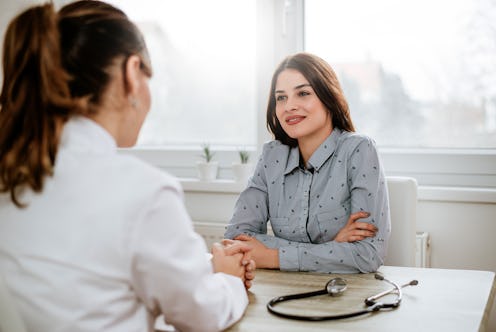
Ever since she began getting her period at age 11, Sarah J. dreaded "that time of the month." It wasn’t just because getting your flow can be, well, inconvenient, it was because of the pain she knew would be coming with her menstrual cycle. Sarah was experiencing more than the traditional period symptoms — her periods included severe pain that could, at times, affect her daily activities.
At first, Sarah thought every woman went through this. “I just assumed other women were experiencing the same symptoms but weren’t talking about them,” she says. And so she tried to deal with it. But eventually, she came to the realization that she needed professional help.
“My doctor tried treating my period pain with birth control and surgery — but nothing provided relief,” Sarah tells Bustle. “For so long I thought the pelvic pain I was going through was all in my head.”
Finally, at age 21 — after talking to more than 10 doctors — Sarah was diagnosed with endometriosis, a condition where the tissue that normally only forms the interior lining of the uterus (called the endometrium) is found outside the uterus [1]. According to the American College of Obstetricians and Gynecologists (ACOG), it’s not uncommon — with endometriosis occurring in about one in 10 women of reproductive age [2]. However, even though so many women share this same health issue, it so far hasn't changed the fact that many women find themselves having to speak to multiple physicians before receiving a proper diagnosis [3,4].
While it took Sarah longer than she’d like to be diagnosed and figured out a treatment that works for her, these are the steps she followed to finally get help for her endo pain.
1. Monitor Your Symptoms
Endometriosis symptoms can be different for every woman. While some women may experience no symptoms at all, ACOG says the most common complaint is reoccurring pelvic pain before and during menstruation [2]. Depending on where endometriosis is affecting someone, it’s possible to also experience pain during sex, bowel movements, or urination [2].
Because women don’t all experience the same symptoms, endometriosis can be tricky to diagnose. The first step you can take to help determine if you might have endometriosis is to monitor your symptoms. Whether it's with pen and paper, your calendar, or a specific period-tracker app, keeping track of your symptoms can be the first step in spotting patterns and helping a doctor pinpoint an accurate diagnosis.
2. Be Your Own Advocate
It took Sarah nearly two decades to find a treatment that works for her endo pain, but it could have taken even longer had she not continued to push to find something. She credits having proactive, honest conversations with her doctors about the debilitating pain she was experiencing for eventually finding relief:
“I am so happy I was persistent in seeking answers and followed my doctor’s recommendations, because now my endometriosis pain has decreased."
3. Understand The Available Treatment Options For Endometriosis Pain
While there is currently no cure for endometriosis, treatment options are available for endo pain. Both medical and surgical treatments for endo pain can be effective, but treatment should be determined based on each woman's individual situation [5,6]. Just because one option doesn’t work well for you doesn’t mean they all won’t work. According to The American Society for Reproductive Medicine, treatment options for endometriosis pain can range from holistic approaches like acupuncture to medical therapies (such as over the counter pain medications and hormonal medications including birth control) and even surgery [5]. It's important to talk to your doctor and research your options, especially if you've tried several treatments without finding endometriosis pain relief, like Sarah. In her case, a new OBGYN recommended a specific treatment option that works for her to help ease her endo pain. Having an open dialogue with your doctor can help determine the appropriate course of treatment for you.
Disclaimer: Everyone’s personal health experience is different. Please seek advice from a medical expert before making any changes to your healthcare routine.
This post is sponsored by AbbVie.
References:
[1] Bulun SE. Mechanisms of Disease: Endometriosis. N Engl J Med. 2009;360(3):268-279.
[2] The American College of Obstetricians and Gynecologists (2019). Frequently Asked Questions: Endometriosis. https://www.acog.org/Patients/FAQs/Endometriosis.
[3] Nnoaham K, et al. Impact of endometriosis on quality of life and work productivity: a multicenter study across ten countries. Fertil and Steril. 2011;96:366-373.
[4] Giudice LC. Clinical practice: Endometriosis. N Engl J Med. 2010;362(25):2389– 2398.
[5] The Practice Committee of the American Society for Reproductive Medicine. Treatment Of Pelvic Pain Associated With Endometriosis: A Committee Opinion. Fertil Steril. 2014 Apr;101(4):927-35.
[6] The American College of Obstetricians and Gynecologists Practice Bulletin. Management of Endometriosis. Obstet Gynecol. 2010 Jul;116(1):223-36.
US-ORIL-190728